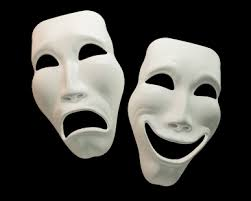THEATER AND DRAMA IN ANCIENT GREECE
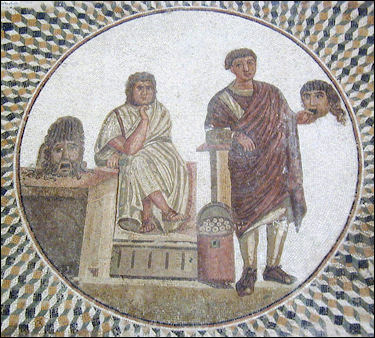
Roman mosaic of Greek drama The Greeks are regarded as the inventors of drama. The Egyptians produced simple plays about the pharaoh's birth at his crowning and plays about resurrection at the pharaoh's funeral. The Greeks produced complex dramas, with developed characters, themes and plots that are still present in drama today. With its elaborate masks and costumes and rigidly formalized music, Greek drama has been described as a cross between Japanese Noh theater and grand opera.
The word “drama” is derived from Greek words meaning “to do” or “to act." There have traditionally been two types of plays: 1) tragedies (plays with a tragic ending) and comedies (plays that are funny). Explaining why comedies exist is easy: people like to be entertained and amused. Understanding why tragedies exist is more difficult to grasp. Aristotle explains that at least part of the attraction is the purging effect of releasing emotion while watching a play.
Greek dramas never had more than three actors on stage at one time. Action in the plays was held to a minimum and violence occurred only offstage. Music was supplied by a flutist who led the chorus. The chorus ceremoniously entered and exited at the opening and closing of a play.
Traveling puppets provided entertainment in ancient Greece and Rome. Magic as a form of entertainment was known to the Egyptians, Greeks and Romans.
The Greeks were one of the first people to use advertising. Announcers shouted announcements during the lulls of cattle actions and handbills made of papyrus were tacked up at community bulletin boards. Prostitutes at Ephesus advertised their services outside the doorway of the brothel with an inscription of a foot and a woman with a mohawk haircut."
Kottoabis is one of the world first known drinking games, A fixture of all-night parties and reportedly even played by Socrates, the game involved flinging the dregs left over from a cup of wine at a target. Usually the participants sat in a circle and tossed their dregs at the basin in the center.
Ancient Greek Parties and Symposia
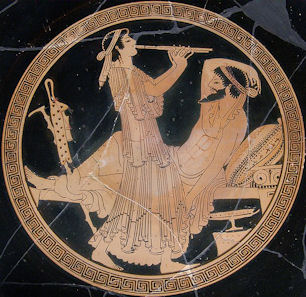
Banquet scene A symposium was a dinner party with family, friends or associates. It generally began with a bout of drinking, followed by a big meal. There were often rules to ensure equality. Conversation topics included philosophy, politics, gossip. For a short period Greeks used birthday cakes.
The word symposia was used to describe the party and the place were it was held and is the source of the modern word symposium. The parties were usually lead by a feast master. Sometimes the guests wore garlands. Some people drank heavily; others held back.
There are vivid description of party entertainment in Xenophon's dialogue Symposium (380 B.C.). The host pays a man from Syracuse to bring traveling performers (probably slaves), a girl flutists, acrobats, a dancing girl and a boy who dances and plays the kithara , a kind of lyre. The group played music and did performances involving music, dance, acrobatics and mine. The girl juggled hoops, performed acrobatic stunts over a hoop rimmed with knives, and acted out mythical love scenes with the boy. Socrates, one of the guests, was quite taken with the boy.
The citizens of Sybaris in present-day southern Italy were such big partiers they reportedly banned roosters so the populous would not be woken to early in the morning. They also supposedly had wine piped directly from the vineyards to the city.
Wild Dionysus Festivals
To pay their respect to Dionysus, the citizens of Athens, and other city-states, held a winter-time festival in which a large phallus was erected and displayed. After competitions were held to see who could empty their jug of wine the quickest, a procession from the sea to the city was held with flute players, garland bearers and honored citizens dressed as satyrs and maenads (nymphs), which were often paired together. At the end of the procession a bull was sacrificed symbolizing the fertility god's marriage to the queen of the city. [Source: "The Creators" by Daniel Boorstin,"]
The word “maenad” is derived from the same root that gave us the words “manic” and “madness”. Maenads were subjects of numerous vase paintings. Like Dionysus himself they often depicted with a crown of iv and fawn skins draped over one shoulder. To express the speed and wildness of their movement the figures in the vase images had flying tresses and cocked back head. Their limbs were often in awkward positions, suggesting drunkenness.
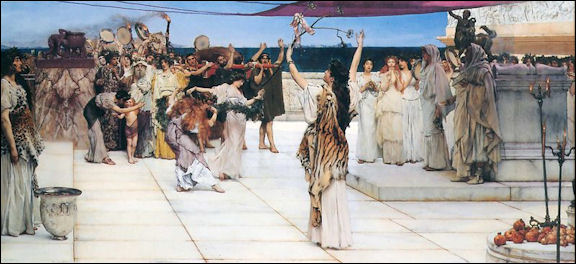
Lawrence Alma-Tadema's Dedication to Bacchus
The main purveyors of the Dionysus fertility cult "These drunken devotees of Dionysus," wrote Boorstin, "filled with their god, felt no pain or fatigue, for they possessed the powers of the god himself. And they enjoyed one another to the rhythm of drum and pipe. At the climax of their mad dances the maenads, with their bare hands would tear apart some little animal that they had nourished at their breast. Then, as Euripides observed, they would enjoy 'the banquet of raw flesh.' On some occasions, it was said, they tore apart a tender child as if it were a fawn'"μ
One time the maenads got so involved in what they were doing they had to be rescued from a snow storm in which they were found dancing in clothes frozen solid. On another occasion a government official that forbade the worship of Dionysus was bewitched into dressing up like a maenad and enticed into one of their orgies. When the maenads discovered him, he was torn to pieces until only a severed head remained."
It is not totally clear whether the maenad dances were based purely on mythology and were acted out by festival goers or whether there were really episodes of mass hysteria, triggered perhaps by disease and pent up frustration by women living in a male'dominate society. On at least one occasion these dances were banned and an effort was made to chancel the energy into something else such as poetry reading contests.
Other Ancient Greek Festivals
There were two major festival for Athenian women every year: The Thesmophoria promoted fertility and honored Persephone with piglet sacrifices and the offering of mass-produced statues of the goddess to receive her blessing. The Adonia honored Aphrodite's lover Adonis. It was a riotous festival in which lovers had openly licentious affairs and seeds were planting to mark the beginning of the planting season.
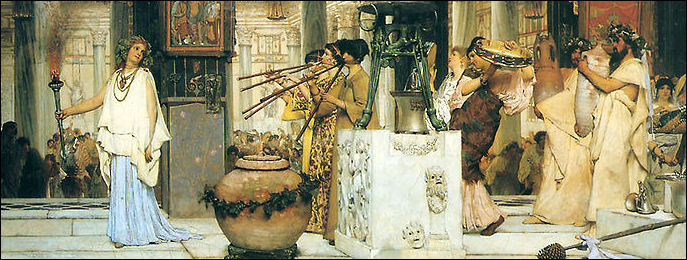
Lawrence Alma-Tadema's Vintage Festival
During Thesmophoria, an annual Athenian event to honor Demeter and Persephone, women and men who required to abstain from sex and fast for three days. Women erected bowers made of branches and sat there during their fast. On the third day they carried serpent-shaped images thought to have magical powers and entered caves to claim decayed bodied of piglets left the previous years. Pigs were sacred animals to Demeter. The piglet remains were laid on an Thesmphoria altar with offerings, launching a party with feasting, dancing and praying. This rite also featured little girls dressed up as bears.
Ancient Greek Theaters
The Epidaurus Theater in Epidaurus (70 kilometers south of Corinth) is the most famous and best preserved ancient amphitheater theater in Greece. Built into a hillside surrounded by trees in the 4th century B.C., the theater has a circular stage and enough seats for 14,000 people. The acoustics are so good it is said an actor's whisper can be heard in the back row.
How is it possible for music and voices to be heard with such clarity in the back rows? Limestone seats form an acoustics filler that hushes low-frequency background noises such as the murmur of the crowd and reflects high-frequency noises of the performers on stage off the seats and back towards the seated audience members. The theater is also very steeply sloped (30 to 34 degrees). This is creates a shorter path for direct sound with few interferences in that direct path. [Source: MCT, Georgia Institute of Technology]
At the 8000-seat marble amphitheater in Aphrodisias in Asia Minor, audiences watched masked and robed actors perform dramas about conspiring slaves and two-timing wives. When the show was over the audience was discouraged out of a gate called the vomitorium .
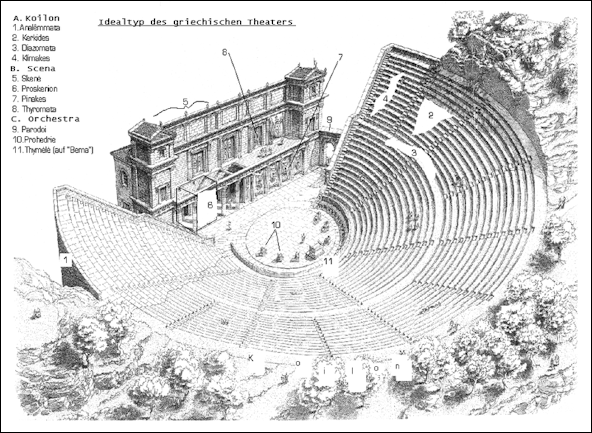
Greek theater
Origins of Ancient Greek Drama
Ironically, the early forms of the Greek dramatic arts, which puts so many of us to sleep, sprung up out orgiastic Dionysian rites. The first phase of the metamorphosis began in the 7th century B.C. when the frantic dances of the maenads evolved into choral songs called dithyrambs. Dithyrambs were performed by a "circular chorus" of 50 men and boys who sang and danced around an altar in the orchestra area of a theater.
See Wild Dionysian Festivals
Tribal choruses competed against one another in festivals sponsored by wealthy citizens. The first prize was a bull and a tripod dedicated to Dionysus, second prize was an amphora of wine, and third prize was a goat. At this point in time music, poetry and drama were essentially the same thing and the subjects of the poem-songs were the Greek myths and episodes from the Iliad and Odyssey . Fertility festivals started dying out around this time because the harvests and rains they promised to deliver failed to arrive. [Source: "The Creators" by Daniel Boorstin,"]
Early Greek Theaters
To accommodate large crowds at festivals, open theaters were built in the 5th century B.C. The first Greek theaters were probably nothing more than wooden benches placed around the outside of an agora where dramas were acted out. Greece and Asia Minor were blessed with a hilly landscape and the Greek theaters that replaced the makeshift market stages were usually carved into the sides of hills.

Epidaurus Theater
At first wooden benches were set up, but later they were replaced by stone or marble seats. The first theaters had a circular orchestra for singers and dancers. This followed the tradition of the early Dionysus festivals when the merrymakers danced around a maypole, altar or image of a god. Theaters built later on had a vomitorium , so named because it discouraged the audience after a performance. [Source: "The Creators" by Daniel Boorstin,"]**
There are 120 ancient theater scattered around Greece. Most have curved rows of concentric seats. In back of the orchestra was a hall-like building with changing rooms and support for the scenery.
Development of Ancient Greek Drama
The development of drama took place on two fronts. First was the introduction of an audience. At a Dionysus festival most everyone was a participant in the events. A choral music festival, in contrast, was entertainment, with large numbers of people watching the events and not dancing or singing themselves. The next important step was the introduction of "actors"---people who stepped out of the chorus, bringing the singing to a halt, and acting out a skit.
This dramatic innovation paved the way for Sophocles, Shakespeare, Rogers and Hammerstein, and Steven Spielberg. It enabled the audience too look upon actors and believe, for moments at a time, that they were different individuals than the people they really were, and they were acting out events that could be taking place in a different time. [Source: "The Creators" by Daniel Boorstin,"]
Some scholars credit the success and influence of Greek drama to The Capture of Miletus , a forgotten play by a forgotten playwright named Phyrnichus that was produced for the Dionysian festival in 492 B.C. The play was about a famous battle between Greeks and Persians lost by the Greeks that took place two year earlier. The play made audiences so depressed that laws were passed forbidding plays based on real life events. With a few exceptions, dramas after that were largely based on a rich supply of myths and famous stories.
Masks and Drama Contests in Ancient Greece

drama competition In 534 B.C. the idea of masks were introduced to help define the persona of the actor by an actor named Thespis who painted his face with white lead and hung flowers from his ears. Masks allowed actors to play many different characters. Chorus members of all dramatic genres wore masks and costumes of characters depicted.
Playwrights competed in fairly frequent contests, meaning they had to be prolific as well as talented. For each competition dramatists were required to write a play about three-fourths of the length of Hamlet. Awards were given out based on the decision of a panel of ten judges. At the Greater Dionysian Festival awards were given in three categories: 1) tragedy, 2) comedy and dithyramb.
As the competitions evolved dithyrambs were replaced with theatrical dramas and there were separate categories for tragedy and comedy. The chorus was incorporated into the dramas and to entertain the audience between the acts. Later the chorus played increasingly insignificant roles and was essentially phased out. Early on many of the actors were amateurs. As time went on professionals began to dominate.
During the Gold Age of Greece, productions of dramas was often paid for by wealthy citizens; attendance was often required for religious reasons; and the state paid the price of admission for the poor.
Politics and Drama in Ancient Greece
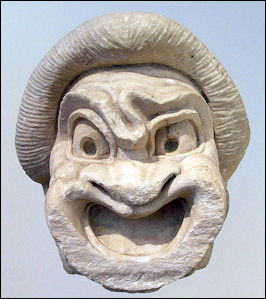
Mary Beard wrote in the New Statesman, “In ancient Athens, politics and theatre went hand in hand. Art, literature and drama blended easily with Athenian imperialism and with the version of "democracy" that underpinned it. Sophocles - the 5th-century BC playwright whose tragedy Oedipus the King was part of the inspiration for Freud's "Oedipus complex" - is a nice example of how the blend worked."Source: Mary Beard, New Statesman, October 14, 2010]
In 440BC, a few months after his Antigone won first prize at the Athenian drama festival, Sophocles served as one of the commanding officers of an Athenian task force that sailed off to put down a rebellion on the island of Samos. The inhabitants had decided to break away from Athens's empire - the network of Athenian satellite states spread all over the eastern Mediterranean - and they had to be brought back into the fold. The irony was that a few decades earlier, Athens had led Greece to victory against a vast Persian invasion; now, the Athenians had imposed their own tight control over their former allies (which may have left some wondering whether conquest by the Persians might have been the better option). More equal than others
The people of Samos got off lightly. They were brought back by force into "alliance" (as the euphemism was) with Athens but there was no mass enslavement, no massacre of the male population, no occupying garrison permanently stationed there, no confiscation of land, such as we find elsewhere in the Athenian orbit. The penalty paid by the Samians was modest - an imposed democracy, the removal of the island's independent naval deterrent and vast sums to pay in financial compensation over years to come.
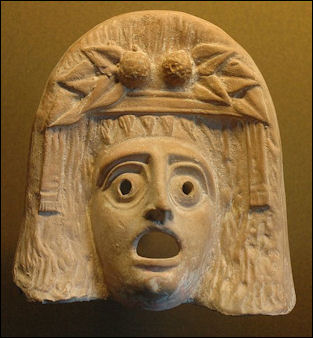
Dionysos_mask All the same, it is hard to think that one month Sophocles was putting the finishing touches to his great Antigone - a play about ethical conflicts between the individual conscience and the dictates of the state - and the next month he was sailing off to force the Samians to toe the Athenian line once again. Yet, oddly, at the time, there was a common story that he was elected to his military command because of the popular success of Antigone, that celebration of individual liberty. Stage of empire
Or maybe it is not so odd. True, the great tragedies that were acted on the Athenian stage debated all kinds of moral and ethical issues, from incest and matricide to the workings of the divine will. But the festival at which those plays were first performed was one of the most jingoistic moments of Athenian culture - and became increasingly so over the second half of the 5th century, during the period of Sophocles's lifetime.
The plays may have debated the rights and wrongs of the exercise of power, but the rituals that went on just before the performances showed no hesitation whatsoever about Athenian control in the world. The most dramatic of these was the presentation of the tribute in cash from Athens's subject states to the Athenian authorities - deposited, it seems, directly on to the theatre stage. This spectacle, however, was followed by a parade that would have fitted easily into the public ceremonials of Soviet Russia: war orphans, those whose fathers had died fighting for the Athenian empire, were trooped across the stage.
Famous Ancient Greek Playwrights
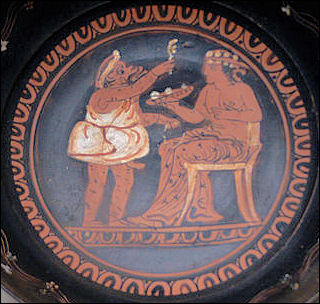
Dionysos and an actor Greece's most famous dramatists---Aeschylus (525-426 B.C.), Sophocles (496-406 B.C.), Aristophanes (450-357 B.C.) and Euripides (485-406 B.C.)---are associated with the Golden Age of Greece. They were based in Athens and competed frequently in the drama contests. Aeschylus won the prize thirteen times and Sophocles won it 20 times, defeating Aeschylus once and losing to Euripides on another occasion. [Source: "The Creators" by Daniel Boorstin,"]
Of the 92 plays written by Euripides only 18 remain, and of the 122 by Sophocles and 82 by Aeschylus only seven from each playwright are with us today. No works exist by Agathon, described as most innovative Greek playwright and the only one who didn't adapt well known stories."
Little is known about the lives of Aeschylus, Sophocles, and Euripides. Based on the content of their plays, some scholars have suggested that Sophocles and Euripides were gay.
Aristophanes, See Comedies
Ancient Greek Tragedies
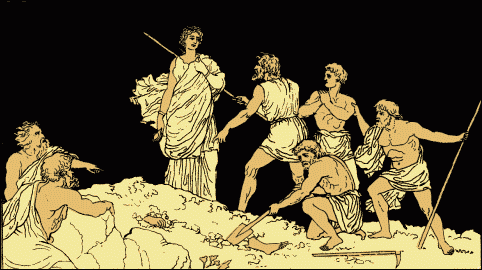
Antigone and the body of Polynices The word “tragedy” is derived from the Greek words tragos (“goat”) andode (“song”), a reference to the costumes worn by actors in the chorus dressed as satyrs. Aeschylus introduced the idea of tragedy, but he did not involve his characters in a conflict. Instead the main character in his plays was a solitary hero wrestling with himself or with destiny. In his early plays action centers around a chorus. In his later plays a tragic hero appears. Aeschylus is also "famous for his knottiness, his clotted images and riddling compound words."
Many of Aeschylus’ plays were trilogies. The only one that remains, The Oresteia, consists of three parts:Agamemnon , Choephori and Eumenides set during the Trojan Wars. He also wrote Persae , a victory song connected with the defeat of the Persians, and Prometheus Bound , a classic retelling of the Prometheus myth. [Recommended Books: The Oresteia by Aeschylus, new translation by Ted Hughes (Farrar, Straus & Giroux, 1999) and The Oresteia by Aeschylus, a brash and slangy translation by Anne Carson (Faber & Faber, 2009).
Sophocles developed more complex plots and introduced more characters and more philosophical themes. He is considered the most Greek of the Greek playwrights. His plays include Oedipus (see below),Ajax and Electra .
Greek tragedies tackled very complex moral issues: the role of crime and justice in society (Aeschylus'sThe Oresteia ), the nature of moral responsibility (Sophocles' Oedipus plays), the character of the divine (The Bachae ) and the conflict between individual and society (Sophocles' Antigone ). Tragic heros often were brought down by a “tragic flaw” in the character.
Euripides
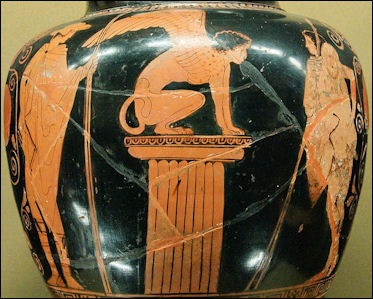
Oedipus sphinx Euripides had even more characters than Sophocles and focused on more human issues. He won less drama prizes than Sophocles and Aeschylus in part because his works were so emotional and disturbing. He invented a pulley and crane system that lowered and raised the gods in and out of the action. Once the crane was used to portray Socrates as being so lost in thought he was floating in the air.
Euripides wrote The Women of Troy ,Hippolytus , Iphigenia ay Aulis , The Bachae, Medea and Hecuba . One of the surprising things about them is how relevant they remain in their commentary on war and the human condition even though they were written more than 2,400 years ago. Nearly all of his works were written during the tragic 27-year-long Peloponnesian War and themes of many his plays deal with tragic lessons he learned from the conflict.
The Times of London theater critic Benedict Nightingale wrote: “Want to know about the limitations of reason as they're being painfully demonstrated by nationalist demagogs, feral children, crazed cults, suicide bombers and assorted other fanatics? Try... The Bachae ...When Euripides writes of war, usually taking Troy as a paradigm, his scepticism, scorn for politicians and horrified mistrust of the human animal reality hits home... The Trojan Women , a long howl of grief...may be the greatest of all anti-war plays."
Many of Euripedes works feature scheming and cruel women. Medea kills her husbands and their children to avenge an infidelity. Hecuba blinds a king and murders his children to avenge the death of her own child.
Oedipus
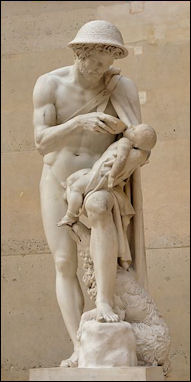
Oedipus Phorbas Oedipus, the King of Thebes, is the most famous tragic Greek character. He killed his father and married his mother and solved the riddle of the sphinx , and gave Freud a name for one of his complexes (See Oedipus Complex, Freud, Austria). Sophocles wrote a trilogy that covers Oedipus and his children: Oedipus the King , Oedipus of Colonus and Antigone .
The Oedipus story begins with Oedipus's father, King Laius learning from an oracle that his son will kill him. He therefore has his newborn son's feet pierced and bound up and left on Mount Cithaeron to die of exposure. A shepherd finds the child, names him Oedipus, meaning swollen feet, and takes him to the King of Corinth, who rears him like a son. When Oedipus is told by an oracle that he will murder his father, he leaves Corinth, thinking its king is his father.
On his journey Oedipus comes across a charioteer, whose servant rudely orders Oedipus out of the way. Oedipus get angry and kills the servant and his msater, without realizing the master is his real father, Ling Laius. Around this time a terrible sphinx appears in Thebes and tells anyone who can not answer the riddle of the sphinx---What animals walks on all fours in the morning, two at noon and three at night?--- will be devoured. Oedipus figures out he answer---man as a crawling baby, upright adult an old man with a cane. Afterwards the sphinx kills herself by leaping off a cliff.
As a reward Oedipus is made King of Thebes and marries his mother. Not long afterwards Oedipus learns the truth: he was killed his father and married his mother. Horrified, he puts out his eyes while his mother hangs herself with her veil. Oedipus becames an outcast but is cared for until his death by his sister Antigone. Antigone is presented as paragon of self sacrifice, which comes out more graphically in her own play.
Ancient Greek Comedies
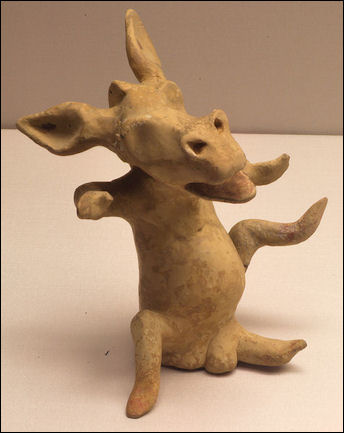
actor as donkey, 5th century BC While tragedies told tales of unapproachable gods and noble heroes, comedies made fun of people from everyday life. Aristotle called comedy an "imitation of men worse than average...that excite laughter...without causing pain."
Comic playwrights had the most fun on the Day of Misrule, a holiday when nothing was sacred. Arcane philosophers were satirized, sexual morality was mocked, and even the gods were objects of ridicule.
In the comedies chorus members sometimes dressed like clouds or wasps. The chorus generally did not interact with the actors but they sometimes taunted them, made lewd gestures directed at them and made jokes at their expense.
Satyr plays burlesqued well known legends and often depicted major characters in gross and obscene manner. The chorus members were dressed like satyrs and responded to the orders of their fat drunken leader, Silenus.
Aristophanes
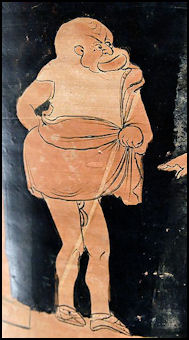
Theatre slave The comic plays of Aristophanes (450-357 B.C.) are the only Greek comedies that have survived. For the most part they featured stereotyped characters we are familiar with today: hen-pecked husbands, nagging wives, boastful soldiers and vain and conniving seductresses. Aristophanes often wrote about issues that affected ordinary Greeks---war, women rights, low pay and sex. He could be viciously sarcastic but often stood up for the rights of the poor.
On the Day of Misrule, Aristophanes went as far as belittling Cleon the Terrible while he was still alive. This ruler was known as "the most violent man in Athens" with a "frown that made people vomit with fear." In one play Cleon was portrayed as a slave who brought trouble to his household. As a punishment he was forced to sell donkey sausages and dog meat on the streets while prostitutes hurled insults and dirty bath water at him. [Source: "The Creators" by Daniel Boorstin,"]
Aristophanes hold the record for longest word ever used in the history of literature---Lopadotemach- oseelachogaleokranioleipsanodrimhypotrimmatosilphioparaomelitokatakenchymenokichlepikossyphophat- toperisteralektryonoptekephalliokigklopeleiolagoiosiraiobaphetraganopterygon. The word appeared in the comedy Eccalziazusae and had 182 letters. It meant a dish made with 17 sweet and sour ingredients, including brains, mullet, vinegar, bone marrow, honey, pickled vegetables and ouzo. [Source: People's Almanac]
Aristophanes's Plays, Women and Sex
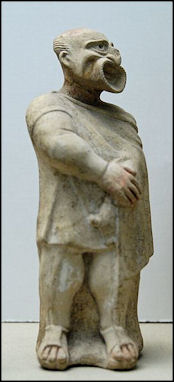
actor Aristophanes plays often poked fun of his contemporaries. His most successful play, both then and now--- Frogs ---ridiculed Sophocles and Euripides, only a year after they died, with characters dressed in frog costumes. The Wasps satirized the Athenian legal system by portraying juries and lawyers as raking in money by prolonging trials. The Clouds ridiculed the Sophists for practicing "Thinkery," a philosophy in which the "Worse Cause appeared the Better." Once he was denied a drama prize for making too much fun of Solon. Aristophanes's other plays are Birds , Knights , Lysieria andEcclesiazususae .
The comedy “Lysistrata” features a heroine who tries to bring the war to an end by leading a sex strike. There is reason to believe that Lysistrata herself is drawn in part from a contemporary historical figure, Lysimache, the priestess of Athena Polias on the Acropolis.
Homosexuality popped in some of his plays. Relationships between older men and teenage boys was believed to be common. In Clouds Aristophanes wrote: "How to be modest, sitting so as not to expose his crotch, smoothing out the sand when he arose so that the impress of his buttocks would not be visible, and how to be strong...The emphasis was on beauty...A beautiful boy is a good boy. Education is bound up with male love, an idea that is part of the pro-Spartan ideology of Athens...A youth who is inspired by his love of an older male will attempt to emulate him, the heart of educational experience. The older male in his desire of the beauty of the youth will do whatever he can improve it."
In Aristophanes's The Birds , one older man says to another with disgust: "Well, this is a fine state of affairs, you demanded desperado! You meet my son just as he comes out of the gymnasium, all rise from the bath, and don't kiss him, you don't say a word to him, you don't hug him, you don't feel his balls! And you're supposed to be a friend of ours!"
Ancient Greek Actors
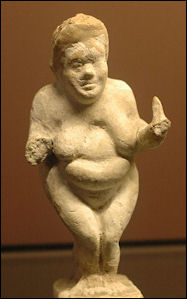
fat woman Actors routinely wore conspicuously short costumes with massive woolen phalluses hanging out the bottom. The first actor was a man named Hyprocites (the word hypocrite was first used around Chaucer's time).
Actors wore heavy wooden-soled boots and elaborate and expensive costumes paid for by wealthy citizens who tried to outdo each other in outrageousness and extravagance. After the performance was over the wealthy patrons got to keep the costume."
Actors worked long hours. Some trilogies were written to be performed in their entirety in one day.
Image Sources: Wikimedia Commons, The Louvre, The British Museum
Text Sources: New York Times, Washington Post, Los Angeles Times, Times of London, Yomiuri Shimbun, The Guardian, National Geographic, The New Yorker, Time, Newsweek, Reuters, AP, Lonely Planet Guides, Compton's Encyclopedia and various books and other publications. Most of the information about Greco-Roman science, geography, medicine, time, sculpture and drama was taken from "The Discoverers" [∞] and "The Creators" [μ]" by Daniel Boorstin. Most of the information about Greek everyday life was taken from a book entitled "Greek and Roman Life" by Ian Jenkins from the British Museum [||].
© 2008 Jeffrey Hays
Last updated January 2012


